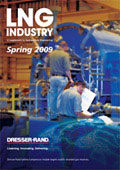Editorial comment
The rapidly changing economic and commodity pricing environment will have profound impacts on the business models of LNG producers and other market participants along the natural gas value chain.
Register for free »
Get started now for absolutely FREE, no credit card required.
The rapidly changing economic and commodity pricing environment will have profound impacts on the business models of LNG producers and other market participants along the natural gas value chain. New liquefaction coming online over the next fouryears and dramatic growth of unconventional gas supply in North America will struggle for market share in the Atlantic basin. Every day, the financial risk to producers is increasing as the economic outlook for all major gas consuming regions grows dimmer.
During the writing of this article, North America’s Henry Hub is pricing sub US$ 4.00, Brent crude oil is US$ 40.55/bbl and UK gas prices continue to soften. Our outlook for gas prices is generally lower than the current forward futures price for multiple seasons into the future. The major drivers to this price outlook are:
- Decreased global energy demand; Asian LNG vs. oil for power production is spotlighted.
- New liquefaction coming online 2008 - 2012: 108 million tpy (14.4 Bcfd; 408 MCMD).
- Oil price linkage in a lower crude and product pricing environment.
- Dramatic growth in USA domestic production and potential.
- Reversal of demand in Spain, which soaked up Atlantic basin supply 2007 - 2008.
The LNG market’s hopes of emerging demand in China, India, Kuwait, Turkey, and South America still linger, but are not enough to support longer term prices at levels sufficient to encourage more investment in upstream resources. LNG producers also seem to be banking on the fact that much of their new capacity is contracted to buyers, but history shows us that if buyers have over committed their purchases in dire economic times, that ultimately they do not or cannot take the committed volumes. The final hope of LNG producers is that North American producers will reduce drilling quickly enough to cause production declines sufficient to make room for incremental LNG imports. This final hope will come true, but at what price level and what cost to the producer’s bottom line?
The battle of the Atlantic pitting LNG suppliers against each other, shale gas production in the USA, Norwegian North Sea gas and Russian pipeline supply will play out in a volatile and unpredictable fashion. Many LNG suppliers are unaware of the potential downside they face when a stream of cargos is slated to enter these already oversupplied markets. They could face negative realisations in the UK and sub US$ 1 realisations in the USA markets. These dynamics may create increased LNG spot trading as sellers look for alternative market outlets for their production.
Large marketing and trading companies that have a significant presence in European and North American gas markets help producers access liquid markets on both sides of the Atlantic and assist clients to manage and mitigate their gas price and volume risks. A skilled and experienced marketing and trading company has the ability to manage both physical supply and financial positions to allow producers to capture value across time and commodities in a changing market environment. Access to multiple markets, storage capacity and transportation as well as robust market analytics, quantitative structuring and 24/7 global trading capability are important elements that can help to avoid lowest price outcomes.

